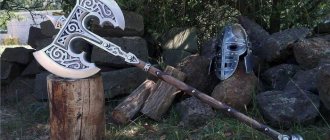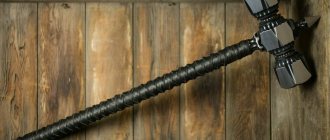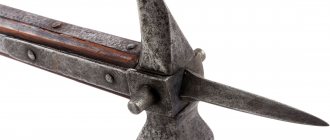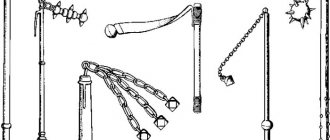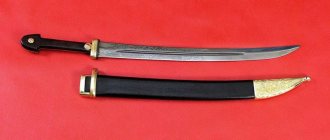In the large family of edged weapons, the battle ax occupies a special niche. Unlike most other models, the ax is a universal weapon. It dates back to the beginning of time, and has managed to maintain its popularity to this day.
There are many myths and legends associated with it, although the ax itself is often not some kind of special sacred weapon, like, for example, a sword. It is rather the workhorse of war, something without which it was impossible to conduct battles or organize a decent camp.
The emergence of weapons
The first examples of battle axes appear since people learned to make axes from stone and tie them to sticks with tendons. At that time, a battle ax was no different from a working one.
At a later time, people learned to make polished battle axes from smooth cobblestones. Several months of careful sanding resulted in an attractive and terrifying weapon.
It was already difficult to use it for cutting down trees, but it broke through heads unprotected by helmets excellently.
The archaeological culture of battle axes passed from Altai to the Baltic, leaving along its path the burials of men and women armed with these weapons.
Man's mastery of metal made it possible to create more advanced examples of battle axes. The most famous models are celts and labryses. The celt was an ax with a socket instead of a butt.
The handle of such a weapon was either cranked or straight. Researchers believe that the celt was a universal tool, equally suitable for both work and battle.
Labrys, on the contrary, was a weapon of warriors or a ceremonial object of priests.
The Greek word labrys refers to a double-edged axe, widely used during the birth of ancient Greek civilization.
Only a physically strong, dexterous and skilled warrior could cope with such a weapon. An inexperienced warrior with a labrys was more dangerous to himself, since the second blade could hit him on the head when swinging.
In skillful hands, the heavy bronze blade delivered terrible blows, from which not every cuirass or shell could protect.
Gerber Downrange Tomahawk.
This ax looks like an Indian throwing tomahawk, however, in its appearance only its shape resembles an ancient Indian weapon. Otherwise, this is a formidable tactical tool with which you can not only chop wood, but also build a shelter, dig holes, drive stakes and much more.
Its feature is an all-metal construction, which ensures high strength and reliability during heavy work. For its manufacture, high carbon steel 420HC is used. Thanks to the hole in the ax handle for a comfortable grip, you can use it as a lever. The handle is made of stainless steel and G-10 pads, which are resistant to aggressive environments and water.
Axes in antiquity and the Middle Ages
Sources describing the opponents of the Roman legionaries highlight Germanic tribes armed with Francis. The name of this type of battle ax came from the Frankish tribe, although this weapon was common among all Germanic tribes. Francis were distinguished by a small impact surface, and therefore great penetrating force.
Axes differed in purpose, as well as in the length of the handles.
Francis with short handles threw into the enemy's formation, long ones were used for cutting with the enemy.
During the decline of the Roman Empire and in the early Middle Ages, new fans of battle axes appeared, striking fear throughout continental Europe. Northern warriors, Vikings or Normans happily used these weapons.
The use of axes was associated with the poverty of the northerners. The metal for swords was very expensive, and the production itself was complex and labor-intensive, and every man had an axe, without which one could not live in the north.
After the campaigns, having become rich, the warriors acquired swords and many other weapons, but the ax continued to play a leading role. Bruenor the battleaxe would have approved of the choice of the northern brothers. Even the Varangian guard of the Byzantine emperor was armed with large axes.
The famous Viking weapon was the Brodex.
A two-handed battle ax mounted on a long handle caused terrible injuries due to the additional force. Armor made of leather or fabric was not an obstacle at all for the Brodex, and the metal of this weapon was often crushed and turned into worthless pieces of iron.
In total, the gun in question came from the following types of combined weapons:
- halberd, hatchet mounted on a pike;
- berdysh, a wide ax blade on a long handle;
- chased, with a narrow blade for maximum effective penetration of armor;
- a poleaxe, a reed-like weapon on a long handle with a wide blade;
- valashka, a small hatchet on a staff handle;
- Polex, a combined universal foot combat weapon with a tip and a butt-hammer.
The increasing complexity of military affairs required new types of battle axes. To protect against cavalry, the ax was crossed with a pike to form a halberd, which made it possible for the infantryman to pull the rider off the saddle.
Among the Russians, this idea resulted in the creation of a berdysh, a battle ax capable of stabbing a horse and rider due to its narrow pointed toe. In mountainous areas, dangerous both by nature and population, small Wallachians appear, universal specimens, with the help of which you can both prepare firewood and knock the spirit out of attackers.
The pinnacle of development was the creation in the 16th century of the polex, the distinguishing feature of which was the spike at the top.
Polex could be of different shapes, but it was always distinguished by its complex pommel design and versatility, since it could be used both as a piercing and as a crushing weapon.
Franziska
During the reign of the Roman Empire, the main barbarian weapon was also an ax. The Germanic tribes used any available axes in battle, and as such, these tribes did not have a distinction between a battle ax and a household axe, however, they had the no less famous Francis - a battle ax.
This powerful weapon could have a shaft either long or short. With a long handle it was used in close combat, and with a short handle it was used as a throwing weapon. This weapon was nicknamed the “flying axe.” By the way, the warriors tied a leather cord to the shaft of the ax so that in case of an unsuccessful throw, the weapon could be pulled towards them.
Battle ax in Rus'
Slavic tribes began to use battle axes long before the invention of writing. Since the neighbors of the places where the Slavs lived were not inclined towards a peaceful life, every man had to have a weapon.
According to legends, ax blades were sharpened so that you could shave your head with them. And the Slavs learned to use an ax in construction or protecting their farms from childhood.
Data from archaeological excavations indicate the influence of Slavic axes on Scandinavian ones, or vice versa, depending on which sources you believe. In any case, the Russian battle ax had much in common with the weapons of the Scandinavians.
A right angle, a downward bevel of the blade, a small area of the cutting part itself, features of both weapons. From a military point of view this is justified. It was almost useless to hit a body wrapped in furs, and even with chain mail, with a wide blade.
The narrow blade of the warrior's battle ax penetrated almost any defense.
A cleaver was used effectively for the same reason. The dull blade did not need to penetrate the armor; it crushed the bones under the armor.
Many folk legends tell about lumberjacks who were chopping wood and were caught by enemies and robbers, and it was the cleaver who helped them fight off.
In the north of Rus', battle axes were used as the main weapon for a long time. The warriors of Novgorod the Great armed themselves with them “according to the behests” of their fathers and grandfathers. In the northeast, these weapons were also widely used.
Archaeologists excavating battle sites find several axes for each sword.
These are mainly models of “beard-shaped” axes, with an extended heel and lower part of the blade.
After the beginning of the Tatar-Mongol yoke, the ax remained perhaps the only means of protection from both wild animals and robbers. Southerners enriched the arsenal of these weapons with coinage. This sample had a small blade, elongated and balanced by an equally elongated butt.
First copies
In fact, the prototype of the ax was simply a stone, sharpened on one side, which the ancient man held in his hand. He was entrusted with many tasks:
- used as a weapon;
- instead of a hammer;
- like a chisel;
- scraper and others.
Today its appearance has changed a lot and its purpose has been reduced.
@youtesla.ru
Axes in modern times and in modern times
With the proliferation of firearms, the age of the ax is by no means over. These weapons are used not only by Rodion Raskolnikov, but also by such elite units as sappers of Napoleon's Imperial Guard, boarding teams of all countries during hand-to-hand combat, and even soldiers of the Red Army during the Patriotic War.
The driver Ovcharenko, who was transporting ammunition to the front line, surrounded by a sabotage group of about 50 Germans, got his bearings and, not having any other weapons at that time, grabbed an ordinary carpenter's ax from the cart, cut off the head of a Wehrmacht officer, throwing his soldiers into shock. A pair of grenades completed the defeat of the enemy, the soldier received the Star of the Hero of the USSR for this feat.
Modernity makes its own adjustments to the conduct of combat.
Today, new models of battle axes are becoming widespread. Made from the latest generation steel grades, in different shapes and sizes. They are lightweight and very durable.
Such axes have proven themselves quite well as a universal tool in raids. It can be successfully used in hand-to-hand combat and as a throwing weapon, and of course, you can simply chop firewood at a rest stop. Excellent specialized axes are now being produced for tourists, rock climbers, etc.
Modern ax
Today, the ax is used by rescuers, police and military personnel. One of the popular types of universal tools has become the tactical ax. It is an ergonomic and powerful tool that has several functions.
Now his arsenal may include tools such as a hammer, a device for unscrewing nuts of various diameters, a nail puller, a sling cutter and much more. The ax handle casing can contain items such as flint, knife, whetstone, and more. An excellent example of such an ax is the Gerber Downrange Tomahawk.
Ax in popular culture
Not a single self-respecting work of the fantasy genre, be it a game or a book, can do without the hero of the article. They arm gnomes, frantic and strong fighters, with axes.
At the same time, many developers forget that short fighters cannot fully take advantage of the effectiveness of the weapon in question.
The dwarf can deliver a crushing blow from top to bottom with a heavy ax into the protected chest of an enemy of average height. But for the authors this convention has no meaning, and they still create numerous, similar, stern dwarves with huge axes.
The weapons themselves act as valuable artifacts in the world of online games.
For example, the battle ax of the unfortunate is considered a valuable artifact, which can be obtained by completing a chain of quests.
The ax did not find much response in historical literature. The bulk of the stories are related to swords, swords or sabers. At the same time, axes remain in the background, but their importance as a massive and effective weapon does not suffer from this.
First step
Translated from French, “trench” means “chisel.” It was these pointed stones, which were obtained after successful chipping, that became the prototype of the stone ax. When they were first used not even by people, but by humanoid creatures, scientists do not have a consensus. But when a person tied a wooden handle to the trench with the veins of an animal, archaeologists more or less suggest - about 35 thousand years BC. It probably seems very simple today - attach a handle to a stone for convenience? But for the first hunters it was a revolutionary step. The fact is that the simply tied stone was not securely held on the stick and immediately flew off from a serious blow. To solve the problem, people had to learn how to drill stone. It would seem that this operation is even more complicated. But our ancestors drilled stone... with wooden drills! To do this, they used the simplest abrasive - sand or rock chips. They also knew how to drill using a tubular bone (again with sand), bamboo, a stone drill or a copper tube. But the drilled chisel initially turned out to be thicker, and its blade could no longer cut sharply, but was a cleaver or hammer that crushed wooden fibers. But in this case, too, a solution was found. A narrow chisel without a hole was simply inserted into the ax handle and secured with animal sinews. As has already been said, man made the first ax by successfully splitting a stone. Later, Neolithic craftsmen began to grind stones rather than chop, so that the chisel would be sharper and more uniform. Archaeologists call such wedge-shaped axes “Celts.” They were made from different types of stone: jade, jadeite, porphyrite. The blades were not only ground, but also polished to achieve serious sharpness. At the same time, they began to use transverse fastening of the chisel on the handle. Such axes were called “adze”. However, axes and adzes were made not only from stone. Thus, in Mesopotamia, axes were made from highly baked clay. And in Polynesia they used bone and shells. It is believed that the ancients did not work, but suffered with such axes. That’s how it is, but at first they tried to make the ax handle, not the “blade,” copper. But chisels continued to be made from stone, because they were more efficient. Thus, flint or obsidian had extreme sharpness, inaccessible to copper. But the copper “blade” was not so fragile.
What is a cleaver
Axes of this type can be either small or large. Such tools have a shifted center of gravity and are significant in weight. They are used mainly for chopping coarse, knotty logs for firewood and are a kind of mixture of a sledgehammer and an ax itself.
The blade of this type of tool is made of hardened steel. Most often it has a straight shape. But sometimes on farms you can also find cleavers with a slightly rounded blade. Handles of this type of ax are always made of very durable wood - for example, elm or oak.
The blade of the cleavers is wedge-shaped and easily fits into any, even the densest, wood. The butt of this type of ax is similar to a hammer. With its help, you can easily drive wedges into a stubborn deck.
